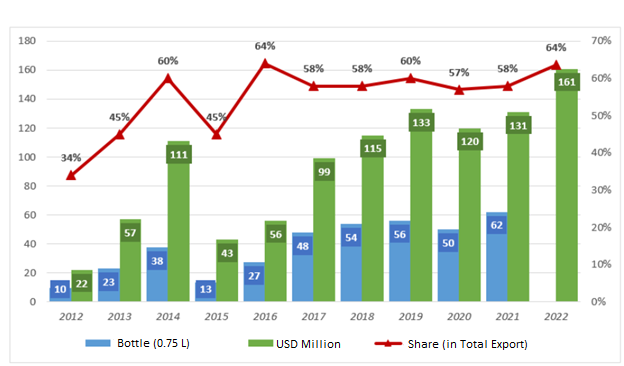Otar Shamugia: “Wine export is growing. The growth rate was around 30% in the last year and this year, too, we have a massive growth in this direction in six months.”
Verdict: FactCheck concludes that Otar Shamugia’s statement is HALF TRUE.
Resume: According to the data of the foreign trade portal, some 101,662.02 tonnes of wine worth USD 252.5 million were exported from Georgia in 2022. In 2021, these figures were USD 239.2 million and 80,465.67 tonnes, respectively. As we can see, growth in 2022 amounted to 5.6% as compared to the previous year. If we take the volume indicator, growth would be 26.3%. In his statement, the Minister is probably referring to the volume of wine exports but he is also exaggerating.
In regard to the six-month period, Georgian wine exports amounted to USD 126.03 million (43,382.81 tonnes) in the first six months of 2023 whilst in the same period of the previous year, wine worth USD 99.8 million (34,063.82 tons) was exported from the country. Accordingly, as compared to the previous year, growth in 2023 is 26.3% whilst the growth of volume reached 27.4%.
Statistical data of the previous year illustrate that total wine export from Georgia increased by 26.3% as compared to the previous year. However, revenues earned from wine export increased by only 5.6%. Therefore, wine was sold for a lower price.
As we know, Russia is the top export market destination for Georgian wines. In 2022, Georgia exported wine worth of USD 160.9 million (69,905.6 tons) which is 22.8% higher as compared to 2021 figures (USD 131 million - 47,355.4 tonnes). In terms of volume, growth is even more impressive at 47.6%. Russia’s share in Georgia’s total wine export revenues increased by six percentage points as compared to 2021 and reached 64%. In 2022, Russia’s share in Georgia’s total wine export in terms of volume was 68.8% whilst it was 58.8% in 2021. Therefore, growth is ten percentage points which proves that wine export growth to Russia is higher in terms of volume as compared to the growth of revenue from export.
Otar Shamugia made this statement to highlight the success in the field of the wine industry. It is true that wine export is growing and Georgia’s wine export reached a historic high last year. However, the Minister named a slightly inaccurate percentage figure and the fact that wine export grows more in terms of volume rather than in terms of revenues from export cannot be proof of success. Therefore, FactCheck concludes that Otar Shamugia’s statement is HALF TRUE.
Analysis
A preparatory meeting for the 2023 harvest was held in the Administration of the Government of Georgia under the leadership of Prime Minister Irakli Gharibashvili where the Minister of Environmental Protection and Agriculture, Otar Shamugia, stated: "It is important that wine export is increasing. The growth rate was around 30% last year and in this year, too, we have a massive growth in this direction in six months. Last year, a record amount in the history of independent Georgia - 103 million litres of wine worth USD 252 million - was exported to 66 countries of the world.”
According to the data of the foreign trade portal, some 101,662.02 tonnes of wine worth USD 252.5 million were exported from Georgia in 2022. In 2021, these figures were USD 239.2 million and 80,465.67 tonnes, respectively. As we can see, growth in 2022 amounted to 5.6% as compared to the previous year.
In regard to the six-month period, Georgian wine exports amounted to USD 126.03 million (43,382.81 tonnes) in the first six months of 2023 whilst in the same period of the previous year wine worth USD 99.8 million (34,063.82 tonnes) was exported from the country. Accordingly, growth in 2023 is 26.3% as compared to the previous year. It seems that Otar Shamugia confuses the statistical data of the previous year and this year. As mentioned earlier, Georgia’s yearly wine export growth reached 5.6% whilst the growth rate is 26.3% in the first six months of 2023 instead of 30% as claimed by the Minister.
Table 1: Wine Export (USD Million)

Source: Foreign Trade Portal
As we know, Russia is the top export market destination for the Georgian wines. In 2022, Georgia exported wine worth of USD 160.9 million (69,905.6 tonnes) which is 22.8% higher as compared to 2021 figures (USD 131 million - 47,355.4 tonnes). In terms of volume, growth is even more impressive at 47.6%. Russia’s share in Georgia’s total wine export revenues increased by six percentage points as compared to 2021 and reached 64%. In 2022, Russia’s share in Georgia’s total wine export in terms of volume was 68.8% whilst in 2021 it was 58.8%. Therefore, growth is ten percentage points which proves that the wine export growth to Russia is higher in terms of volume as compared to the growth of revenue from export.
In the first six months of 2023, Georgia exported 29,991.8 tonnes of wine worth USD 81.8 million. In the same period of the previous year, the respective figures were USD 57.8 million and 21,497.5 tonnes. As compared to the first six months of 2022, the growth rate amounted to 41.5% whilst growth in volume is 39.5%. This year, Russia’s share in total export reached 64.9% whilst Russia’s share was 57.9% in the first six months of 2022. Therefore, Russia’s share in total wine export has increased by seven percentage points in the first six months of 2023.
Russia’s share in Georgian wine export has been changing over years as follows:
Graph 1: Georgia’s Wine Export to the Russian Market in 2012-2022, Million Bottles (0.75 L) GEL Million

Source: National Statistics Office of Georgia
A statistical analysis of wine export shows that the increase or the decrease of Georgian wine exports usually depend on the Russian factor. As we know, Russia banned the import of agricultural products (including wine) from Georgia in 2006 by a decree issued by the Chief Sanitary Inspector of Russia, Gennady Onishchenko, on the basis of Georgian wines being of poor quality. This embargo resulted in a significant drop in Georgian wine export. In 2006, Georgian wine export amounted to USD 41 million whilst it almost halved and decreased to USD 29 million the following year.
In the reporting period, Russia’s share in Georgia’s wine export was the lowest in 2012 (34%) which was stipulated by the aforementioned embargo. Georgian wine export to Russia resumed in June 2013. In 2013-2014, Georgian wine export increased significantly, largely because of the lifting of the trade ban on Georgian wines (2013 – 128 million, 2014 – 185 million). In 2015, it was Russian factor that again caused a decline in Georgian wine export. That year, instability in Russia and Ukraine significantly affected Georgian wine export and resulted in a 39% drop in exports (USD 96 million). The events unfolding after 20 June 2019 (Russia’s threat to impose sanctions on Georgian products) demonstrated yet again that Russia is an unreliable trade partner which often uses trade relations with Georgia for political purposes. Russia’s recent decision to resume direct flights to Georgia confirms this judgement.
Therefore, the aim of the Georgian government should be the reduction of economic dependence on Russia. However, a look at Georgian wine export proves the opposite that the dependency on Russia it is increasing. The growing dependence on Russia’s unstable and unpredictable market will not bring economic or political benefits to Georgia neither in the short-term nor in the long-term perspective.
Otar Shamugia made this statement to highlight success in the field of Georgia’s wine industry. It is true that wine export is growing and export reached a historic high last year. However, the minister named a percentage figure with a slight exaggeration. The fact that wine export grows more in terms of volume rather than in terms of revenues from export cannot be proof of success. Therefore, FactCheck concludes that Otar Shamugia’s statement is HALF TRUE.








